Japan Wood Products
Prices
Dollar Exchange Rates of
10th April 2015
Japan Yen 120.20
Reports From Japan
Weaker yen and low energy import costs improve
trade balance
The Ministry of Finance has reported that the February
current account surplus was the highest in almost four
years but much of the improvement stemmed from the
conversion to yen of companies overseas income but was
also helped by falling import costs due to lower oil prices.
Analysts expect the current account to remain in surplus as
long as the yen remains weak and oil and natural gas
prices do not rise.
Medium and small Japanese firms look to international
markets
In January the Japan External Trade Organization
(JETRO) conducted a survey of domestic Japanese firms
engaged in exports of agricultural, forestry, fishery and
food products.
The survey assessed attitudes towards exports of
agricultural, forestry, fishery and food products,
challenges and issues, competitors in export destinations
and future strategies.
The following summarises the main points in the JETRO
report.
Attitude to exports
 82% of respondents are placing more
emphasis 82% of respondents are placing more
emphasis
on exports due in part to shrinking domestic
demand.
 56% intend to increase exports over the
next three 56% intend to increase exports over the
next three
years. Food makers noted the rise in popularity of
Japanese foods overseas.
Challenges and issues
Amongst export destinations in which Japanese firms face
challenges are China followed by the US, South Korea, the
EU then Taiwan P.o.C.
Specific issues identified include difficulties in
understanding local regulations and rules particularly in
the US, China and the EU.
 51% of firms reported a lack of
information 51% of firms reported a lack of
information
regarding consumer trends in export markets.
 50% indicated that they were not able
to gather 50% indicated that they were not able
to gather
sufficient information on local buyers including
credit ratings and other commercial data.
Exporters reported high logistic and overall
transaction cost.
Competitors in export destinations
Chinese and S. Korean firms are major competitors in all
markets. Regarding the strengths of competitors, price was
ranked first followed by efficiency in distribution and
sales.
Future strategies
Regarding specific measures to expand exports,
strengthening of the sales functions (personnel, bases, and
promotion) and strengthening product development were
commonly cited.
For the full details see:
https://www.jetro.go.jp/en/news/2015/20150409737-news
Yen down on expectations of rate rise in US
The yen fell slightly to 120.20 to the US dollar in mid
April as the dollar continued to gain strength on
expectations the US Federal reserve will soon begin to
raise interest rates.
In related news the Bank of Japan (BOJ) steered clear of
any additional monetary easing at its last meeting. After
the meeting the BOJ Governor voiced optimism that the
dampening effect of last years‟ tax increase has dissipated.
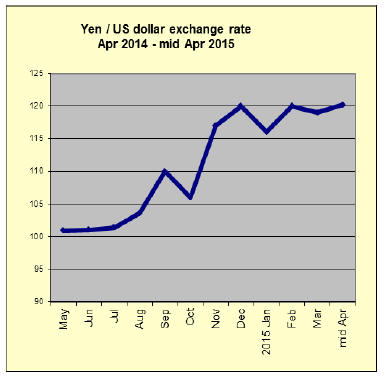
Widely divergent land price trends to be addressed
The Ministry of Land Infrastructure and Tourism reports
that land prices in Tokyo Osaka and Nagoya, the three
major cities, rose 0.4% in February following the 0.5%
rise in the same month a year earlier. Commercial land
values also rose (plus 1.8%) after the 1.6% in February
2014.
Interest rates on housing loans are currently very low and
this has helped drive up land prices. However, nationwide
land prices continue to fall highlighting the persistent
deflation.
The difference in land price trends between the large cities
and the rest of Japan is a challenge for the government and
the risk is that current efforts to boost the economy are not
addressing issue outside of the export manufacturing
sectors.
Those with investments in land or the stock market are
benefitting from current fiscal policies but the average low
and middle income family are having to cut back on
expenditure prices of imported goods rise because of the
weaker yen.
The weak yen is also hitting small sized companies,
especially those which depend on imported raw materials.
For more see: http://tochi.mlit.go.jp/english/landprices/
land-value-look-report
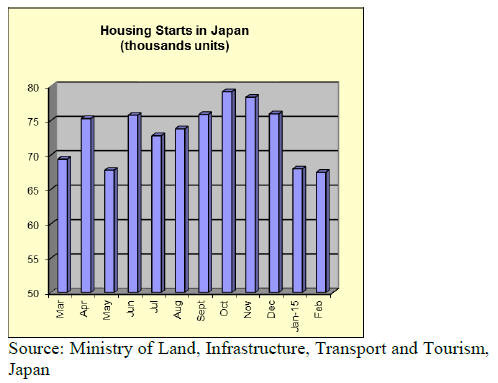
Import round up
February 2105 wooden door imports were down 19% year
on year and compared to levels in the previous month
imports fell 2.5%.
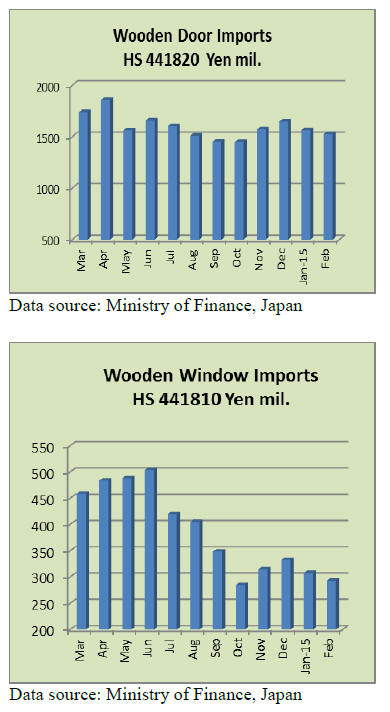
Wooden window imports in February 2015 fell by a
massive 40% year on year and were down 5% from
January.
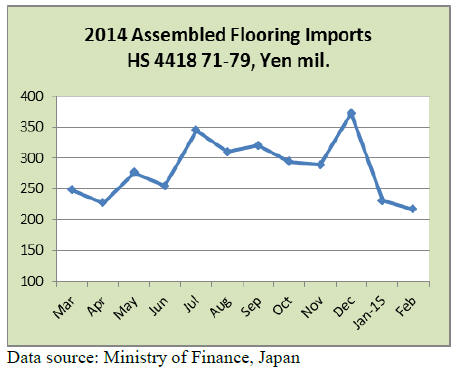
February 2015 assembled flooring imports into Japan rose
2.4% year on year however they fell 6% compared to
levels in January this year.
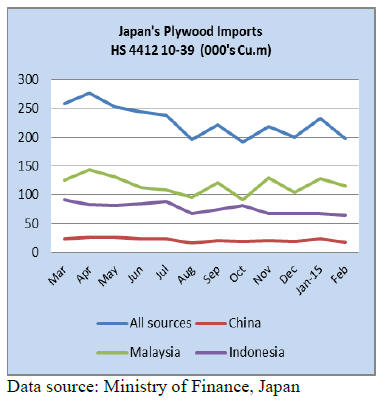
Malaysia is the largest supplier of plywood to Japan but
February imports fell 5% year on year and by 10%
compred to import levels in January.
China‟s exports of plywood to Japan also fell year on year,
dropping 14%. Compared to the level of imports in
January this year February imports fell 2%.
A similar trend was seen with imports from Indonesia
where year on year February 2015 imports fell 7% and
compared the January this year, February imports were
down 3%.
Trade news from the Japan Lumber Reports (JLR)
For the JLR report please see:
http://www.nmokuzai.
com/modules/general/index.php?id=7
Full liberalization of electricity market
Revised Electricity Business Act was approved by the
cabinet meeting on March 3. The main revision is
separation of generation and transmission of electricity.
This means transmission system major electric companies
have monopolized for years is now open for newly
participating business, which is scheduled to start in April,
2020.
This is revolutionary change and this is the final target of
reform of electricity system the government is aiming.
This should support reduction of electricity price and
diversification of the services of power companies.
It is already decided that electricity retail sales is
liberalized since April 2016. With the revision of this time,
each household is allowed to select supply source of
electricity so that renewable natural energy like solar and
biomass power generation should draw more attention.
Accounts of large electricity consumers like industrial
plants have already been liberated but it is not certain if
the cost is lower than before since the contract is made
individually. For common household, there has not been
any choice but to buy electricity from the electric company
in residential area but now consumers have option to select
what type of energy power each company is using to
generate electricity.
Liberalization does not always guarantee lower electricity
cost since other countries experienced higher electricity
cost after banning nuclear generation because of
maintenance cost of transmission system and higher cost
of recyclable materials but significance is that consumers‟
mind decide what kind of electric business is formed in
future. It‟s consumers‟ choice if electricity is generated by
nuclear power or biomass energy, which is renewable
energy and should help vitalize forest resources.
Sumitomo Forestry increases export of domestic logs
Sumitomo Forestry (Tokyo. Akira Ichikawa, the president)
announced to increase forest products export business as a
part of overseas business expansion plans. This year‟s
target volume is about 80,000 cbms, about four times more
than 2014.
Up until last year, the main item of export was logs. About
80% of the market is China then 13% for Korea, 6% for
Taiwan P.0.C and 1% for Vietnam.
China has variety of demand and the price is priority
matter. Any buyer, which designates species is exporter of
finished products to foreign markets. Sumitomo Forestry
Forest Service is in charge of log procurement in Japan
then Sumitomo Forestry will handle shipment and
marketing.
Species are 70% cedar, 20% cypress and 10% larch and
fir. Main supply source is Kyushu with about 60% then 7-
8% from Hokkaido.
In Japan, demand for low grade materials for biomass
generation will increase so to increase procurement may
not be easy but there is a possibility of large expansion of
the demand if the price is right for huge softwood market
in China
South Sea (tropical) logs
firming as all the log yards are almost empty after rainy
season. In Sarawak, Malaysia, weather has been
improving gradually since late February. Control on illegal
logging is severe and in tight supply market, Indian buyers
kept paying high prices for logs to fill up their ships so
FOB prices had kept going up week after week in
February but after meranti regular FOB prices shot up to
$300 per cbm, India finally stopped buying at high prices.
In late February, meranti regular log prices for Japan
market were $280-295, small meranti were $245-260 and
super small meranti were $230. FOB prices for late March
shipment will probably be up again in tight supply and
competition with other countries. Local plywood mills are
running out of log inventory and they compete grabbing
low cost small logs. In late February, many plants had to
shut down because of log shortage.
In PNG and Solomon Islands, weather continues unstable
and cyclone hit in middle of March. Chinese purchase has
been slowing as its log inventories in China are rather
heavy but India is buying aggressively to replace Sarawak
logs. So prices remain high, particularly the logs for Japan,
which are selective in quality.
AI Ply’s price hike
AI Ply, marketing company of Seihoku group, announced
to increase the sales prices as of April 1. In Tokyo market,
12 mm 3x6 structural softwood plywood prices in middle
of February dipped below 800 yen per sheet delivered so
the plywood manufacturers‟ business turned unprofitable.
Then in early March, the prices further dropped.
Major wholesalers held exhibition and spot sale fairs,
which move rather large volume at one time so it could be
turning point to firm up the market but this time, it turned
adversely and the prices further dropped to 760-780 yen.
This triggered price war among wholesalers and trading
firms, which need to close their books at the end of March
and inventory clean-up is their priority matter.
AI Ply thinks that this should be time to bottom the prices
and after closing books, the market should turn round so it
decided not to accept any more low offers after April 1.
Plywood manufacturers in the group have been curtailing
the production by 15% compared to last June then during
the Golden Holidays in early May, the plants will stop
running for a week or ten days to reduce the inventory.
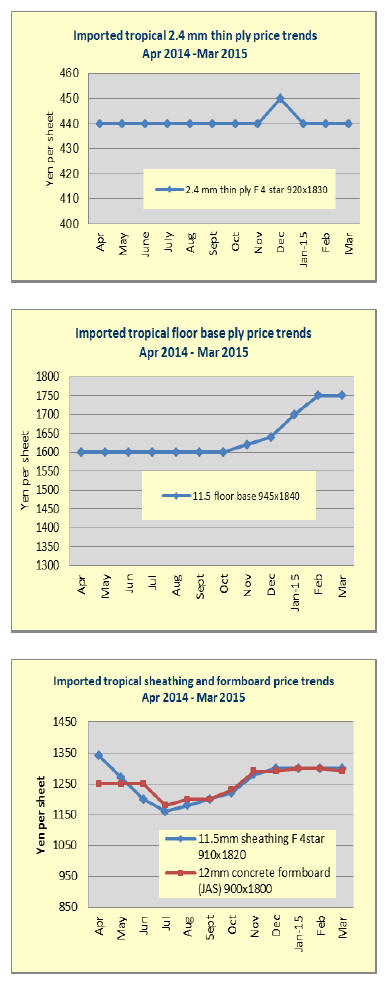
Domestic production of laminated lumber
Japan Laminated Lumber Manufacturers Association
disclosed domestic production of laminated lumber in
2014. Total is 1,555,000 cbms, 5.6% less than 2013. In
structural materials, production of medium and small sized
lumber declined because of demand drop by increase of
consumption tax but large sized lumber increased.
Production of interior finishing lumber stopped declining
since 2011 on both solid wood and veneer overlay lumber
then in 2014, solid wood decorative lumber increased.
The demand expands as construction of large buildings
increased and decorative lumber is heavily used.
Structural lumber recorded the third largest production
behind 2006 and 2013. The production did not drop as
much as 2014‟s housing starts, which dropped by 9%.
However, imported volume in 2014 dropped by 4.4% with
728,000 cbms so total of both imports and domestic
production was in proportion to drop of housing starts.
Large sized lumber is used for large buildings, which
increased in number then imported products lost
competitiveness by weak yen.
Also for medium and large buildings, use of domestic
species is encouraged, which pushed the domestic large
size lumber production up. Percentage of lamina is 63.3%
of European softwood and 24.3% of domestic softwood. A
balance is North American softwood. It looks like share of
60% of European, 30% of domestic and 10% of North
American is fixed.
|